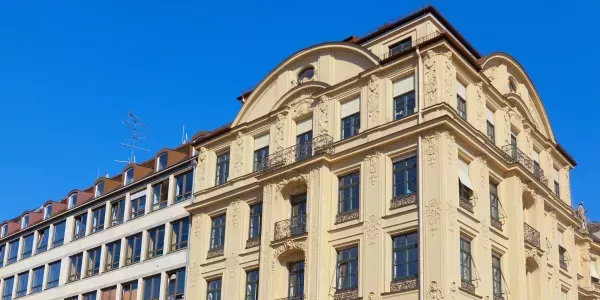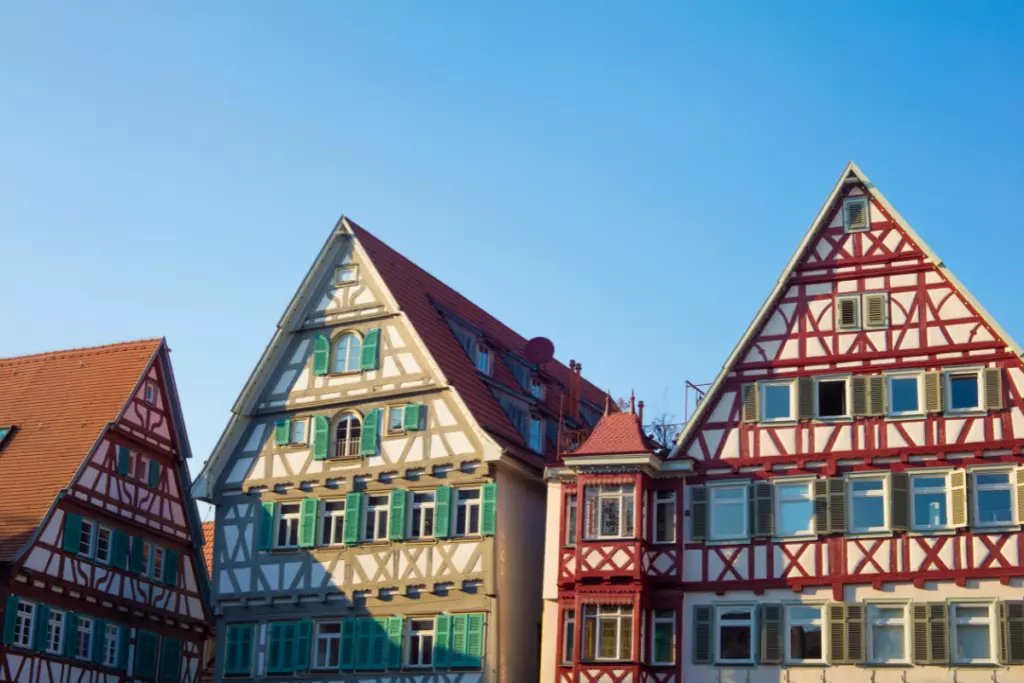German architecture

The early architectural landscape in Germany was dominated by Romanesque and Gothic styles. Romanesque architecture, characterized by its rounded arches and sturdy appearance, can be seen in many of Germany's oldest churches and castles.
The Cologne Cathedral, with its soaring spires and intricate stonework, is a prime example of Gothic architecture, which succeeded the Romanesque style. Gothic architecture brought a sense of verticality and light to German buildings, with its pointed arches, ribbed vaults, and flying buttresses.
The Renaissance and Baroque Periods

The Renaissance and Baroque periods introduced new architectural ideas to Germany. Renaissance architecture, with its emphasis on symmetry, proportion, and geometry, can be seen in the palaces and town halls of many German cities.
The Baroque style, which followed, was characterized by grandeur and opulence, with sweeping curves, gilded interiors, and dramatic facades. The Zwinger Palace in Dresden is a splendid example of Baroque architecture.
The 19th century saw a revival of various historical styles, including Neo-Gothic and Neo-Renaissance, as Germany sought to assert its national identity through architecture. This period also witnessed the emergence of the Jugendstil movement, the German equivalent of Art Nouveau, which emphasized natural forms and structures.
Bauhaus Movement and its big impact on modern architecture

The 20th century brought about a significant shift with the advent of the Bauhaus movement, which originated in Germany. Bauhaus architecture, with its functional design, clean lines, and lack of ornamentation, had a profound impact on modern architecture worldwide. The Bauhaus School in Dessau is a testament to this influential style.
In the post-war era, Germany embraced modernist and contemporary architectural trends. Cities rebuilt after World War II feature modern skyscrapers, innovative housing projects, and cutting-edge public buildings that reflect Germany's commitment to progressive design and sustainable building practices.
Modern German architecture
Today, German architecture is a blend of historic and modern, with medieval structures coexisting harmoniously with avant-garde buildings. This juxtaposition highlights Germany's respect for its past and its forward-looking vision, making it a unique and dynamic landscape in the world of architecture.
What are the characteristics of German architecture?
Half-timbered buildings and A-frame (especially in traditional Bavarian homes) roofs are key characteristics of traditional German architecture, and can be seen all over Germany.
The magnificent castles of Bavaria are one of the first references that come to mind when thinking about German architecture. They mark an important, iconic, and well-recognized era in Germany: The medieval period.

Bavarian House Style
Bavarian-style houses are characterized by their traditional Alpine influence and robust construction suited to the mountainous terrain.
These properties typically feature distinctive Fachwerk (half-timbering), steep gabled roofs ideal for snowy conditions, and ornate woodwork, including balconies with intricate designs. The Lüftlmalerei, or facade paintings, add a unique cultural touch, often depicting local legends or pastoral scenes.

Which materials do they use to build Bavarian Houses?
They are usually built with local materials like wood, stone, and clay. These homes not only blend harmoniously with the natural environment but also offer excellent insulation and energy efficiency, a significant selling point in the colder climate of the region.
The colorful exteriors, often adorned with floral decorations and window boxes, enhance their aesthetic appeal, making them highly sought after in the real estate market.
Half-timbering homes
When thinking about “traditional German architecture”, the half-timbered houses are a great example. This name, Half-Timbering, comes from the way they are built, with the frame exposed. Its building process includes heavy timbers pegged together to create a frame, and the remaining gaps are filled with a filling material.

What are modern German houses made of?
Brick masonry formed of sand and limestone, along with asphalt roof tiles, are the materials that comprise modern homes in Germany. They are built with higher standards of energy efficiency and durability and reflect a different set of values and priorities.
Main differences between American style houses and German style houses
Climate, culture, and building traditions reflect the difference between American style houses and German style houses. In American homes you will find more convenience and comfort, while German style homes focus on the aspect of energy efficiency and durability.
Construction Materials and Technique
American homes typically use wood framing for construction, especially in suburban and rural areas. This is due to the abundance and cost-effectiveness of wood in the United States. Germans more commonly use brick, stone, and concrete, materials that provide better insulation and durability, which is very important given Germany's colder climate.
Energy Efficiency and Insulation
German homes are known for having high energy efficiency standards. They often feature thicker walls, better insulation, and high-quality windows, reflecting Germany’s strong focus on energy conservation. In American homes, energy efficiency standards vary significantly, and traditionally, insulation is not always a high priority, especially in older homes.
Size and Space
American homes are often larger, with more emphasis on spacious living areas, large bedrooms, and multiple bathrooms. While German homes are generally more compact and efficient in their use of space. Rooms are smaller, and homes often have fewer bathrooms.
Design and Aesthetic
American homes exhibit a wide range of styles, including modern, colonial, ranch, and Victorian. There's a greater emphasis on individuality and customization. German homes show a preference for functional and minimalist designs, especially in modern homes. Traditional homes feature Fachwerk (timber-framing) or regional styles like Bavarian.
Heating and Cooling Systems
American homes commonly have central heating and air conditioning systems, reflecting the broader range of climates across the U.S. German homes, on the other hand, are more likely to have gas or oil-fired radiators in each room, and less reliance on air conditioning, due to the cooler German climate.
Outdoor Spaces
American homes typically have larger yards or outdoor spaces, and there's a strong culture of backyard activities and landscaping. Germans focus on efficient and practical outdoor space use and because of that boast smaller gardens or balconies.
Basements and Attics
Basements and attics are often used as additional living or storage spaces in American homes. In German houses, basements are common, but they are more often used for utilities and storage. Attics often are converted into living spaces, especially in urban areas.
Window Styles and Features
in American homes, windows often have screens to keep insects out, a feature less common in Germany. There, windows are typically designed for energy efficiency and may include features like tilt-and-turn mechanisms.
With all these differences, we can say that American homes reflect a lifestyle that prioritizes individual comfort and spacious living, while German homes emphasize practicality, energy efficiency, and are influenced by a strong environmental consciousness.
People also ask
What Types of Materials Are Commonly Used in German House Construction?
Modern residences in Germany are commonly constructed using sand and limestone brick masonry and asphalt roof tiles. Energy efficiency is vital in the construction of new homes nowadays, which are often well-insulated. Surprisingly, around 60% of new homes in Germany are prefabricated.
What Are the Latest Trends in German House Design?
There are three themes that are gaining popularity: sustainability, well-being and comfort. There's a strong emphasis on building homes that are environmentally sustainable and that incorporate smart technology for enhanced comfort, efficiency, and security.
What Are the Key Characteristics of German Style Houses?
German-style houses differ depending on geography and historical time, many share some characteristics. Half-timbered or full-timbered structures, steep roofs, symmetry and balance, and intricate embellishments are examples of these.

 Marcio Vasconcelos
Marcio Vasconcelos





